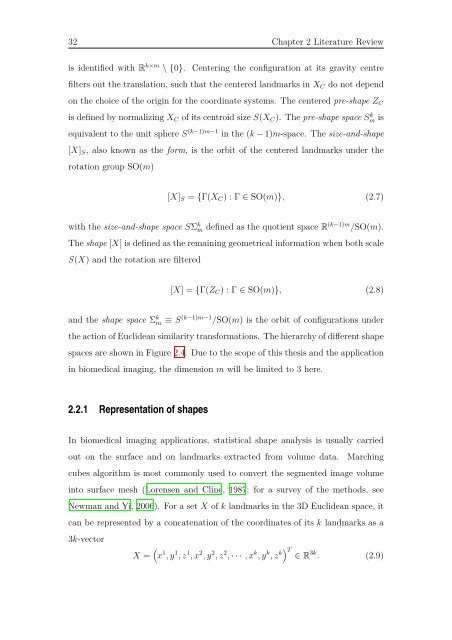Docteur de l'université Automatic Segmentation and Shape Analysis ...
Docteur de l'université Automatic Segmentation and Shape Analysis ...
Docteur de l'université Automatic Segmentation and Shape Analysis ...
You also want an ePaper? Increase the reach of your titles
YUMPU automatically turns print PDFs into web optimized ePapers that Google loves.
32 Chapter 2 Literature Review<br />
is i<strong>de</strong>ntified with R k×m \ {0}. Centering the configuration at its gravity centre<br />
filters out the translation, such that the centered l<strong>and</strong>marks in XC do not <strong>de</strong>pend<br />
on the choice of the origin for the coordinate systems. The centered pre-shape ZC<br />
is <strong>de</strong>fined by normalizing XC of its centroid size S(XC). The pre-shape space S k m is<br />
equivalent to the unit sphere S (k−1)m−1 in the (k − 1)m-space. The size-<strong>and</strong>-shape<br />
[X]S, also known as the form, is the orbit of the centered l<strong>and</strong>marks un<strong>de</strong>r the<br />
rotation group SO(m)<br />
[X]S = {Γ(XC) : Γ ∈ SO(m)}, (2.7)<br />
with the size-<strong>and</strong>-shape space SΣ k m <strong>de</strong>fined as the quotient space R (k−1)m /SO(m).<br />
The shape [X] is <strong>de</strong>fined as the remaining geometrical information when both scale<br />
S(X) <strong>and</strong> the rotation are filtered<br />
[X] = {Γ(ZC) : Γ ∈ SO(m)}, (2.8)<br />
<strong>and</strong> the shape space Σ k m ≡ S (k−1)m−1 /SO(m) is the orbit of configurations un<strong>de</strong>r<br />
the action of Eucli<strong>de</strong>an similarity transformations. The hierarchy of different shape<br />
spaces are shown in Figure 2.4. Due to the scope of this thesis <strong>and</strong> the application<br />
in biomedical imaging, the dimension m will be limited to 3 here.<br />
2.2.1 Representation of shapes<br />
In biomedical imaging applications, statistical shape analysis is usually carried<br />
out on the surface <strong>and</strong> on l<strong>and</strong>marks extracted from volume data. Marching<br />
cubes algorithm is most commonly used to convert the segmented image volume<br />
into surface mesh (Lorensen <strong>and</strong> Cline, 1987; for a survey of the methods, see<br />
Newman <strong>and</strong> Yi, 2006). For a set X of k l<strong>and</strong>marks in the 3D Eucli<strong>de</strong>an space, it<br />
can be represented by a concatenation of the coordinates of its k l<strong>and</strong>marks as a<br />
3k-vector<br />
X = (<br />
x 1 , y 1 , z 1 , x 2 , y 2 , z 2 , · · · , x k , y k , z k) T<br />
∈ R 3k . (2.9)
















